By: Marsha Stephens (with contributions from Nature Center committee members, listed at the end of this article)
First, a huge thank you to all who invested sweat equity (and new plantings) at the Nature Center during the last year. Though individual contributions by chapter members are not noted in this article, you know who you are and you are appreciated, including for new ceramic plant identification plaques and new bluebird boxes. Scientific names for species mentioned in this article are listed at the end.
According to information from the Texas Water Development Board, Office of Water Science and Conservation, 2022 was the driest year on record in Erath County (https://www.myhighplains.com/news/local-news/texas-drought-conditions-worsen-in-dry-january-panhandle-burn-bans-continue). The Bosque River Nature Center definitely provided a demonstration of the drought conditions. Despite efforts to provide supplemental hand-watering, there were few survivors from spring and fall new plantings. Even some established perennials were lost, including two autumn sage plants that were each at least 3 years old. Strangely, although Texas sage (cenizo) is a desert-adapted plant, our specimens also suffered severe damage. By the end of the growing season, the pollinator beds were extremely bare, with no sign of life for many perennials. On the bright side, there was also little growth in the prairie demonstration area, so no controlled burn was conducted during 2022. Thanks to irrigation installed several years ago to serve the tree/shrub section, there was generally good survival of saplings there. A special shout-out to Jim Rogers, who assisted with repair of that irrigation system this spring; Jim gets a special nod because he isn’t even a member of our chapter, just a much-appreciated spouse of a member!
During fall 2022, surface drip lines were placed in the pollinator beds at the Center. The lines are operated via a connection to the below-grade hose bib with a 2-hour timing device. As one member noted, this was a bit of closing the barn door after the horse has left, but it does provide better preparation for the next dry time, and the late season watering surely saved some specimens. Two bluebird houses (complete with predator guards and signage) were mounted on T-posts at the Center; one was placed in the pollinator garden and the other was placed in the prairie demonstration area. The bird feeders previously placed in the beds are not being maintained and need to be either removed or reset and kept filled. One of the resident population of red-shouldered hawks has taken up usage of the garden area for foraging, which may not be appreciated by potential customers of the birdfeeders anyway!
As 2023 began, efforts geared up to reclaim and rejuvenate the pollinator garden. Volunteers faced the annual nemesis of brome grasses, henbit and garden vetch. A pre-emergent application to the path in February helped reduce the annual crop of seedlings, but many hours of removal work were still required. On March 23, we were fortunate to host 15 Tarleton students who showed up for work as part of the Tarleton State University Service Day program. Seven chapter members worked alongside the students, provided food for the participants and contributed new plantings, equipment and other assistance. TSU President Dr. James Hurley also joined in the work for several hours, and noted that he and his wife routinely enjoy the garden on their morning runs and bring their children to see the butterflies. The work included removal of nonnative invasives and new plantings of obedient plant and wild bergamot in the pollinator garden. Part of the work crew also rescued and transplanted selected native plants into the prairie demonstration area from an area in town that is slated for development. There were also prairie plantings of grasses contributed by a member. The prairie zone work included back-breaking excavation and resetting of the border rocks, an effort that remains unfinished and in need of attention.
Despite our many losses in 2022, there are some notable triumphs to start the year. The volunteer black locust tree that showed up in the pollinator garden in 2018 appears to have been vanquished at last, as no root sprouts have appeared this spring. Cut-leaved evening primrose appeared as a new volunteer in the beds, and established a lovely early ground cover in several areas. Volunteer bluebonnets, pink evening primrose and spotted beebalm are also up and blooming. After many years of defeat, one antelope horn milkweed that was planted last year has survived to this spring; it is prominently marked for protection and monitoring. A new Eve’s necklace planted last fall is thriving. The hated tie-vine (sharp-pod morning glory) has not yet reared its head. It’s always an experiment in progress!
To welcome May, the annual job of clearing the outer edge of the pollinator garden has been completed (but will be required again periodically throughout the summer) and removal of invasives within the beds continues. As our climate system shifts back toward El Nino, we are seeing a return of more normal spring rainfall, and many of the perennial plants in the beds have responded with new growth. The dance of the Mexican hats is in progress and cowpen daisies (golden crownbeard) have filled every empty spot and are offering up their exuberance for the returning pollinators. The Henry Duelberg sage, autumn sage and Engelmann daisies are flowering. New additions of purple prairie verbena, snake herb and two color variants of Lindheimer’s beeblossom (formerly considered a gaura) are in bloom. The red yuccas at the entrance have expanded and have many bloom stalks to please the hummingbirds. Clasping coneflower, American germander and red-whiskered clammyweed are up and will be blooming soon. Beautiful false dragonhead and Gregg’s mist flower are growing and will flower in a few weeks. We are in the midst of the three weeks out of the year when the garden is glorious – get down there with your camera and family and friends!
Note: The official monthly work day at the Bosque River Nature Center is fourth Saturdays, 9 to 11:30 a.m. or until you drop. However, if you want to work on other days, just contact one of the Nature Center committee members to meet you there to provide guidance. Current members of the BRNC committee include Meaghan Peoples (leader), Peggy Tolboom, Bill Hopkins, Seth Hamby, Gordon Lee, Jan Rogers and Marsha Stephens.
New Plant Identification Plaque
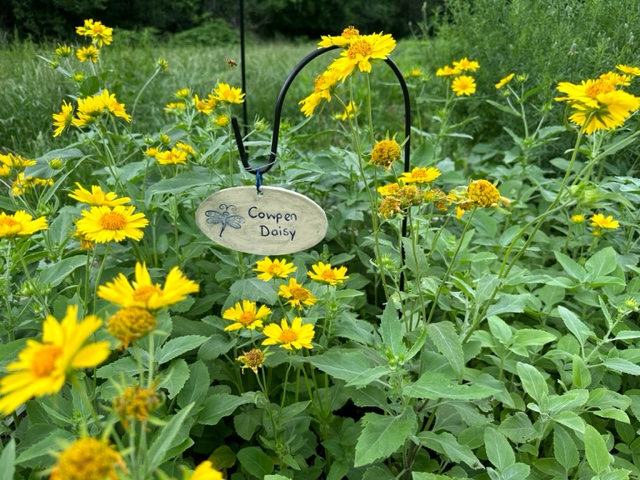
Participants in March 23 Tarleton Service Day
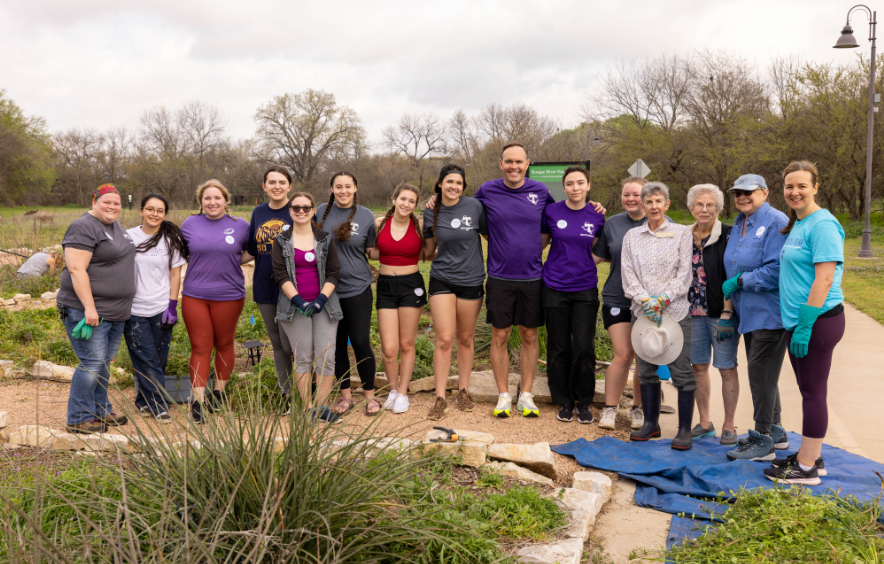
Pollinator Garden Entrance
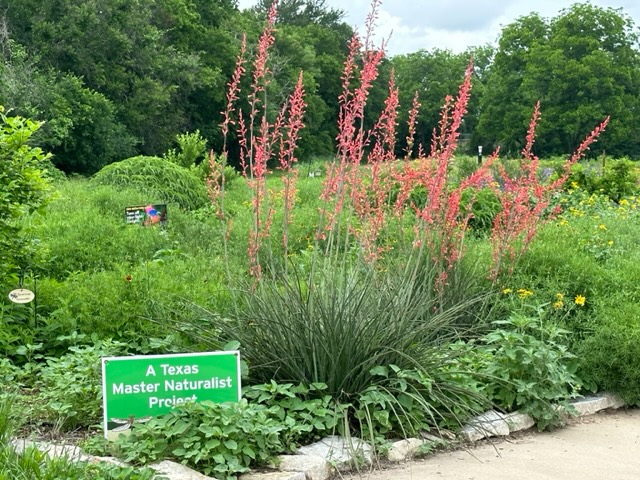
Red-shouldered Hawk and Nature Center Sign
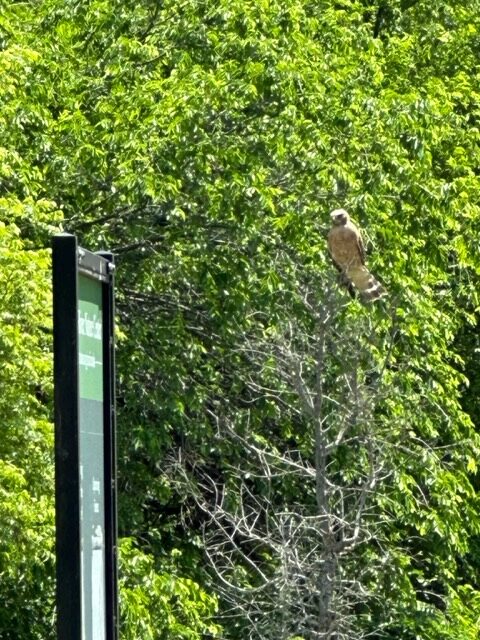
Texas Lantanas, Cowpen Daisies, Henry Duelberg Sage and More!
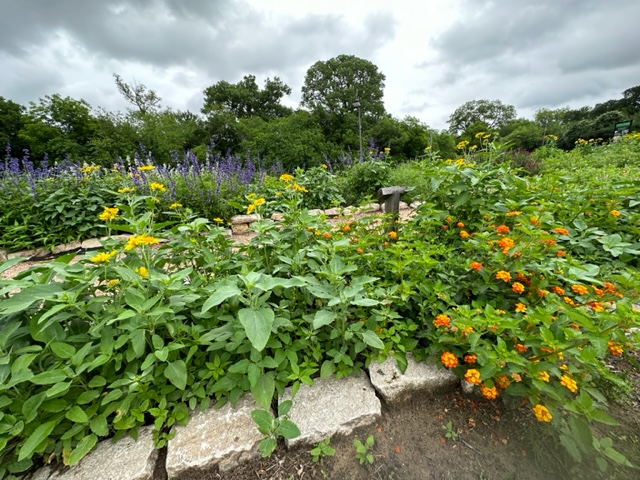
White-lined Sphinx Moth Caterpillar
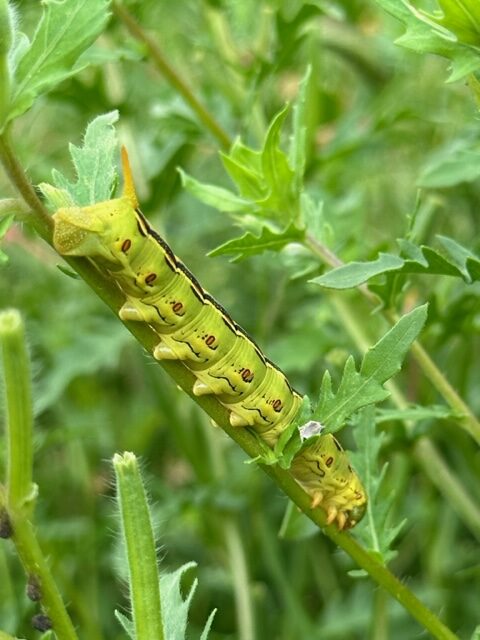
Scientific names for species mentioned in this article:
American germander (wood sage) (Teucrium canadense)
antelope-horn milkweed (Asclepias asperula)
autumn sage (Salvia greggii)
beautiful false dragonhead (Physostegia pulchella)
black locust (Robinia pseudoacacia)
bluebonnet (Lupinus texensis)
brome grass (Bromus spp.)
clasping coneflower (Dracopis amplexicaulis)
cowpen daisy (Verbesina encelioides)
cut-leaved evening primrose (Oenothera laciniata)
Engelmann’s daisy (Engelmannia peristenia)
Eve’s necklace (Styphnolobium affine)
garden vetch (Vicia sativa)
Gregg’s mistflower (Conoclinium greggi)
henbit (Lamium amplexicaule)
Henry Duelberg sage (Salvia farinacea)
Lindheimer’s beeblossom (Oenothera lindheimeri)
Mexican hat (Ratibida columnifera)
obedient plant (Physostegia intermedia)
pink evening primrose (Oenothera speciosa)
prairie verbena (Glandularia bipinnatifida)
red yucca (Hesperaloe parviflora)
red-whiskered clammyweed (Polanisia dodecandra)
snake-herb (Dyschoriste linearis)
spotted bee balm (Monarda punctata)
Texas sage (cenizo) (Leucophyllum frutescens)
tie-vine/sharp-pod morning glory (Ipomoea cordatotriloba)
wild bergamot (Monarda fistulosa)


